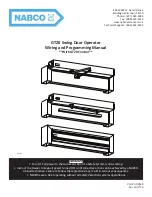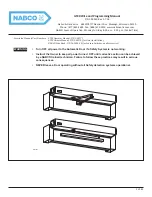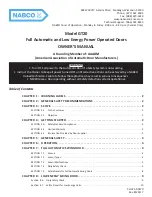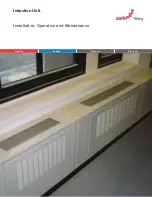
bottle valve.
- Do not direct the mouthpiece of the torch towards parts of the body.
- Keep the torch away from the gas bottle.
- Re-fit the contact tip and the nozzle onto the torch
(4b)
.
- Check that wire feed is regular; set the roller and spindle braking pressure to the
minimum possible values making sure that the wire does not slide in the groove and
when feed is halted the loops of wire are not loosened by excessive reel inertia.
- Cut the end of the wire so that 10-15 mm protrude from the nozzle.
- Close the reel compartment door.
5.7 REPLACING THE LINER IN THE TORCH (FIG. N)
Before proceeding to replace the hose, lay out the torch cable straight without any
bends.
5.7.1 Coiled hose for steel wires
1-
Unscrew the nozzle and contact tip on the torch head.
2-
Unscrew the hose locking nut on the central connector and remove the old hose.
3-
Insert the new hose into the cable-torch duct and push it gently until it comes out of
the torch head.
4-
Tighten up the hose locking nut by hand.
5-
Trim off all the excess protruding hose pressing it slightly; remove it from the torch
cable again.
6-
Smooth the part where the hose was cut and reinsert it into the cable-torch duct.
7-
Tighten up the nut again using a spanner.
8-
Reassemble the contact tip and nozzle.
5.5.2.1 Connection to the gas bottle
The gas bottle can be loaded onto the supporting platform of the trolley
max. 60 kg.
5.7.2 Synthetic hose for aluminium wires
- Screw the pressure reducing valve onto the gas bottle valve, inserting the appropriate
Carry out operations
1, 2, 3
as given for the steel hose (ignore operations
4, 5, 6, 7, 8
).
adapter supplied as an accessory, for when the gas used is Argon or an
9-
Re-tighten the contact tip for aluminium, making sure it comes into contact with the
Argon /CO mixture.
2
hose.
- Connect the gas inlet pipe to the pressure-reducing valve and tighten the band
10-
At the other end of the hose (torch connector end) insert the brass nipple and the OR
supplied;
ring and, keeping slight pressure on the hose, tighten the hose locking nut.
- Loosen the adjustment ring nut on the pressure-reducing valve before opening the
Extract the capillary pipe for steel hoses from the wire feeder torch connector.
bottle valve.
11-
THE CAPILLARY PIPE IS NOT REQUIRED for aluminium hoses of diameter 1.6-
2.4mm (coloured yellow); the hose is therefore inserted into the torch connector
without it.
Cut the capillary pipe for aluminium hoses of diameter 1-1.2mm (coloured red) to
approx. 2mm shorter than the steel pipe, and insert it into the free end of the hose.
12-
Insert and lock the torch into the wire feeder connector, mark the hose at 1-2mm
from the rollers, take the torch out again.
13-
Cut the hose to the required size, without distorting the inlet hole.
Reassemble the torch in the wire feeder connector and assemble the gas nozzle.
Carbon and mild steels
- Suitable wire diameter:
0.6-1.2mm
- Welding current range:
40-210A
-
Arc voltage range:
14-23V
- Suitable gases:
CO , mix Ar/CO , Ar/CO /O
2
2
2
2
Stainless steels
- Suitable wire diameter:
itable gases:
mix Ar/O , Ar/CO (1-2%)
5.5.4 WARNINGS
2
2
-
Turn the welding cable connectors right down into the quick connections , to ensure
Aluminium and alloys
a perfect electrical contact; otherwise the connectors themselves will overheat,
- Suitable wire diameter:
0.8-1.6mm
resulting in their rapid deterioration and loss of efficiency.
- Welding current range:
75-160A
-
The welding cables should be as short as possible.
-
Arc voltage range:
16-22V
-
Do not use metal structures which are not part of the workpiece to substitute the
- Suitable gases:
Ar 99.9%
return cable of the welding current: this could jeopardise safety and result in poor
welding.
Generally, the contact tip should be flush with the nozzle or protrude slightly when using
the thinnest wires and lowest arc voltages; the length of free wire (stick-out) will normally
5.6 LOADING THE WIRE REEL (FIG. M)
be between 5 and 12mm.
___________________________________________________________________
WARNING! BEFORE STARTING THE OPERATIONS TO LOAD THE WIRE
MAKE SURE THE WELDING MACHINE IS SWITCHED OFF AND DISCONNECTED
FROM THE MAIN POWER SUPPLY OUTLET.
Application:
Welding in all positions, on thin material or for the first passage in bevelled
___________________________________________________________________
edges, with the advantage of limited heat transfer and highly controllable pool.
MAKE SURE THAT THE WIRE FEEDER ROLLERS, THE WIRE GUIDE HOSE AND
Note:
SHORT ARC transfer for welding aluminium and alloys should be used with great
THE CONTACT TIP OF THE TORCH MATCH THE DIAMETER AND TYPE OF WIRE
care (especially with wires of diameter >1mm) because the risk of melting defects may
TO BE USED AND MAKE SURE THAT THESE ARE FITTED CORRECTLY. WHEN
arise.
INSERTING AND THREADING THE WIRE DO NOT WEAR PROTECTIVE GLOVES.
- Open the reel compartment door.
- Position the wire reel on the spindle, holding the end of the wire upwards; make sure
Higher voltages and currents than for "short arc" are used here to achieve the melting of
the tab for pulling the spindle is correctly seated in its hole
(1a)
.
the wire. The wire tip does not come into contact with the molten pool; an arc forms from
- Release the pressure counter-roller/s and move it/them away from the lower roller/s
the tip and through it flows a stream of metallic droplets. These are produeced by the
(2a)
.
continuous melting of the electrode wire without short-circuits involved.
- Free the end of the wire and remove the distorted end with a clean cut and no burr;
Carbon and mild steels
turn the reel anti-clockwise and thread the end of the wire into the wire-guide infeed,
- Suitable wire diameter:
0.8-1.6mm
pushing it 50-100mm into the wire guide of the torch fitting
(2c)
.
-
Welding current range:
180-450A
- Re-position the counter-roller/s, adjusting the pressure to an intermediate value, and
-
Arc voltage range :
24-40V
make sure that the wire is correctly positioned in the groove of the lower roller
(3)
.
-
Suitable gases :
mix Ar/CO , Ar/CO /O
2
2
2
- Use the adjustment screw located at the centre of the spindle to apply a slight braking
Stainless steels
pressure on the spindle itself
(1b)
.
- Suitable wire diameter:
1-1.6mm
- Remove the nozzle and contact tip
-
Welding current range:
140-390A
-
Welding voltage range :
22-32V
- Insert the welding machine plug in the power supply outlet, switch on the welding
-
Suitable gases :
mix Ar/O , Ar/CO (1-2%)
2
2
machine, press the torch button and wait for the end of the wire to pass through the
Aluminium and alloys
whole of the wire guide hose and protrude by 10-15 cm from the front part of the
- Suitable wire diameter:
0.8-1.6mm
torch, release the button.
-
Welding current range:
120-360A
___________________________________________________________________
-
weld
Ar 99.9%
WARNING! During these operations the wire is live and subject to mechanical
The contact tip should generally be 5-10mm inside the nozzle, the higher the arc
stress; therefore if adequate precautions are not taken the wire could cause
voltage the further inside; the length of free wire (stick-out) should normally be between
hazardous electric shock, injury and striking of electric arcs:
10 and 12mm.
___________________________________________________________________
5.5.1.2 Connection to the wire feeder
- Make the connections with the electrical generator (rear panel):
- welding current cable to quick connection (+);
- control cable to appropriate connector.
- Make sure the connectors are firmly tightened in order to prevent overheating and
loss of efficiency.
- Connect the gas pipe from the pressure-reducing valve on the bottle and lock it with
the clip supplied.
5.5.1.3 Connecting the welding current return cable
-
This is connected to the piece being welded or to the metal bench supporting it, as
close as possible to the join being made.
-
This cable is connected to the terminal with the symbol (-).
5.5.1.4 Connecting the torch
-
Engage the torch with its dedicated connector by tightening the locking ring
manually as far down as it will go.
-
Prepare the wire for loading the first time by dismantling the nozzle and the contact
tip to ease its exit.
5.5.2 TIG WELDING (FIG. I)
Note. To be able to use the welding machine with this welding procedure IT IS
ESSENTIAL to DISCONNECT the wire feeder.
then connect the other end of the pipe to the connector on the back of the
welding machine and tighten it using the band supplied.
The excess part of the hose will be removed to size later on (see
(13)
).
5.5.2.2 Connecting the welding current return cable
-
This is connected to the piece being welded or to the metal bench supporting it, as
close as possible to the join being made.
-
This cable is connected to the terminal with the symbol (+).
5.5.2.3 Connecting the torch
- Connect the TIG torch to the quick connection (-) on the front panel of the welding
machine; complete the connection of the gas pipe and torch control cable.
6. WELDING: DESCRIPTION OF THE PROCEDURE
5.5.3 MMA WELDING WITH COATED ELECTRODE (FIG. L)
6.1 MIG/MAG WELDING
5.5.3.1 Connecting the electrode holder clamp
6.1.1 SHORT ARC TRANSFER MODE
The machine is designed for two types of connection:
The melting of the electrode wire and the detachment of the drop is produced by
- directly from the wire feeder by connecting the electrode holder cable to the quick
repeated short circuits (up to 200 times per second) from the tip of the wire to the molten
connector designed for this purpose.
pool.
- from the welding machine by connecting the electrode holder cable to the quick
connector (+) on the front panel. In this case it is ESSENTIAL that the wire feeder is
NOT CONNECTED.
Note: in some cases (-) polarity for the electrode holder clamp is recommended, so
check the electrode manufacturer's instructions.
5.5.3.2 Connecting the welding current return cable
-
This is connected to the piece being welded or to the metal bench supporting it, as
0.8-1mm
close as possible to the join being made.
- Welding current range:
40-160A
-
This cable is connected to the terminal with the symbol (-).
-
Arc voltage range:
14-20V
- Su
In MANUAL MODE (“PRG 0”) adjust the reactance value:
-5%-60% with carbon steel wires of diameter 0.8-1mm.
- 50%-80% with carbon steel wires of diameter 1.2-1.6mm.
- 60%-80% with stainless steel and aluminium wires.
6.1.2 SPRAY ARC TRANSFER MODE
- Make sure the puller roller is suitable for the wire being used
(2b)
.
ing voltage range :
24-30V
-
suitable gases :
(4a)
.
- 8 -









































